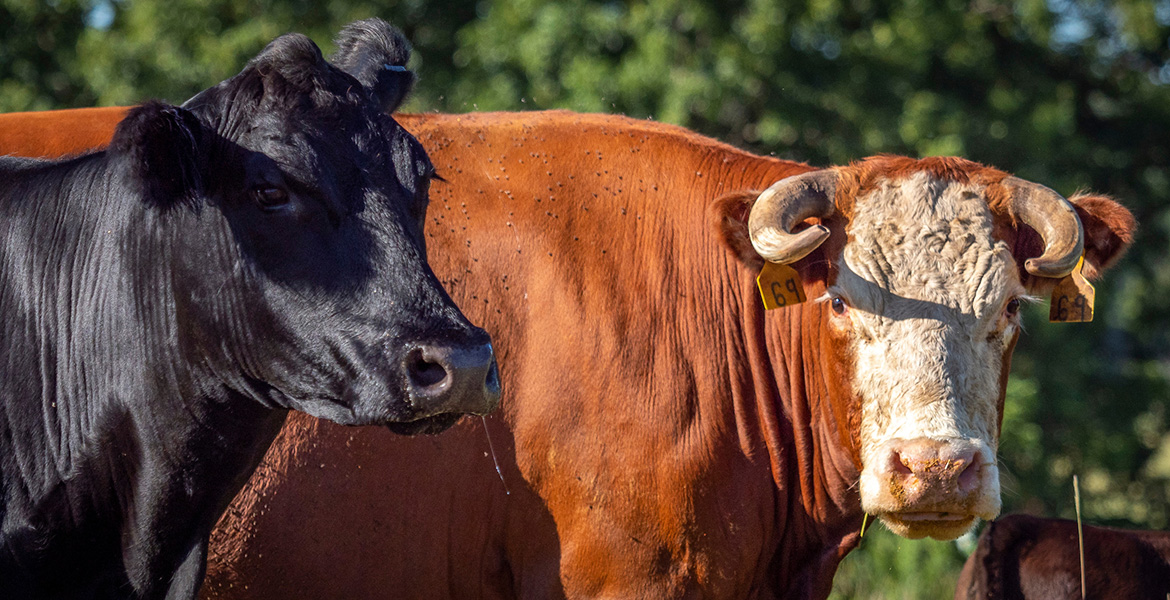
Producers should follow recommended veterinary practices for dehorning cattle
Thursday, August 20, 2020
Producers with horned cattle should develop and implement a dehorning plan that improves efficiency and animal well-being, Oklahoma State University experts said.
“A successful plan involves the use of a written protocol, knowledgeable and skilled personnel and ways to minimize stress and promote healing,” said Dr. Rosslyn Biggs, OSU Extension veterinarian and director of continuing education for the university’s College of Veterinary Medicine. “Seek input from your veterinarian when developing the written protocol.”
A well-designed protocol should address:
- Calf age.
- Personnel training.
- Animal restraint.
- Pain management.
Biggs said the protocol and any notes related to its implementation should be reviewed yearly.
The American Association of Bovine Practitioners updated its guidance for dehorning practices in 2019, separating dehorning recommendations from those for castration and adding pain mitigation strategies. The complete list of recommendations is available online.
It is recommended that dehorning takes place as early as practically possible. There are two common forms of horn removal – disbudding and mechanical removal of the horns. Disbudding involves the removal or destruction of the horn-producing corium cells in young calves.
“This can occur as early as 24 hours of life, but care must be taken to prevent calf injury,” said Earl Ward, OSU Extension area livestock specialist for northeastern Oklahoma. “Disbudding is preferable over mechanical removal, but it’s not always practical for beef producers. Mechanical removal of horns prior to the calf reaching 3 months of age is recommended. Again, producers should follow the plan established with their veterinarian.”
Ward and Biggs said the chances of a successful dehorning improve when the protocol is executed by trained personnel. Training prepares personnel to address wound management to avoid infection, flies and pain for older calves and those with prominent horns.
If using a combination of physical and chemical restraint, make sure facilities are in good working order and able to safely secure the head of the calf. Sedatives should be used only on the order of a veterinarian.
“Although some sedatives may offer pain control, many do not, and pain management should be employed to improve animal welfare following the procedure,” Biggs said.
Local anesthesia can provide immediate relief for several hours following the procedure. Longer-term pain control can be achieved using non-steroidal, anti-inflammatory drugs. However, no such drug is currently labeled for pain relief after dehorning, so whatever is used must be prescribed by a licensed veterinarian.
The Animal Medicinal Drug Use Clarification Act requires the use of an extra-label drug only with a valid veterinary-client-patient relationship, documented drug selection process, records of maintenance and observance of defined withholding times.
Only 7.8% of U.S. beef cattle are horned, a significant downward trend from previous reports, according to the U.S. Department of Agriculture’s National Animal Health Monitoring Beef Cow-Calf Study, which was conducted in 2017 and released this year.
“Genetic selection has played a significant role as the vast majority of beef cattle producers have embraced the concept of incorporating polled genetics,” Ward said. “This trend also likely will be seen in many dairy breeds in the years ahead.”
Consult OSU Extension fact sheets for more information about research-based cattle management practices, available online and through all county Extension offices.
OSU Extension is one of two state agencies administered by the university’s Division of Agricultural Sciences and Natural Resources and is a key part of OSU’s state and federally mandated teaching, research and Extension land-grant mission.
MEDIA CONTACT: Donald Stotts | Agricultural Communications Services | 405-744-4079 | donald.stotts@okstate.edu
